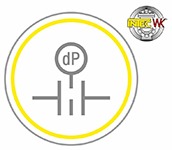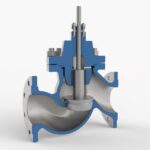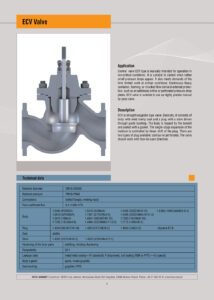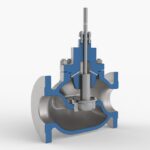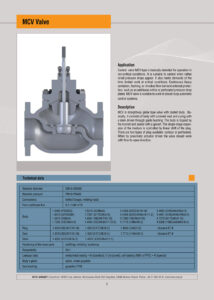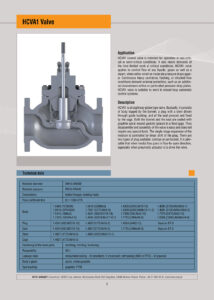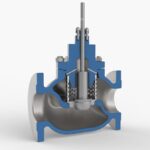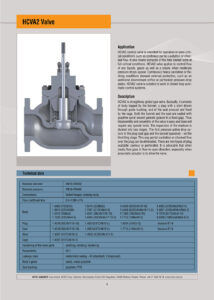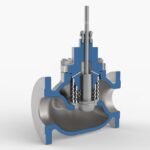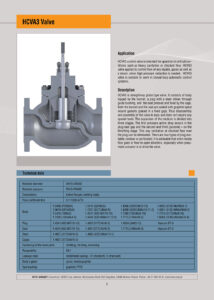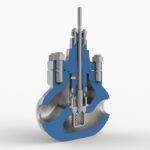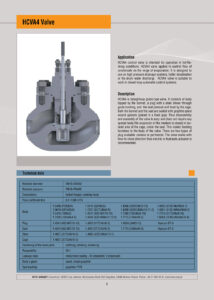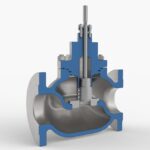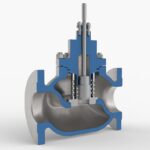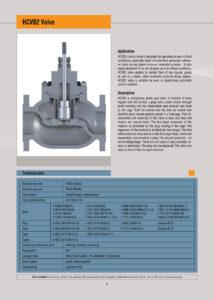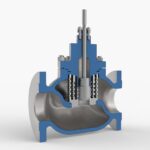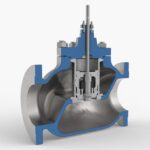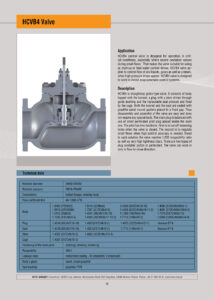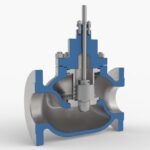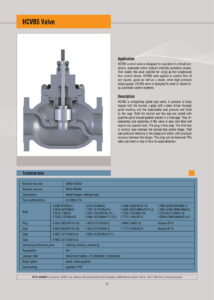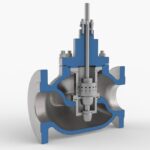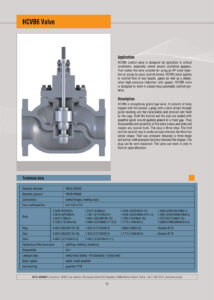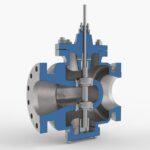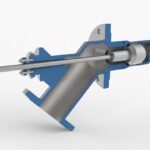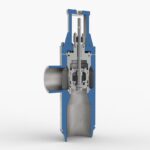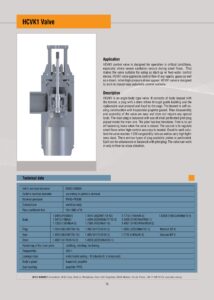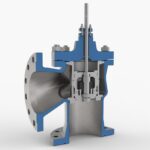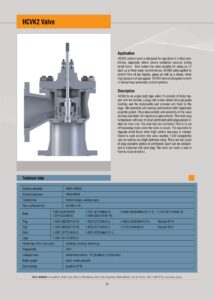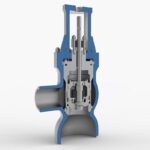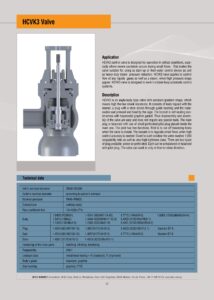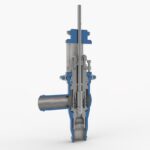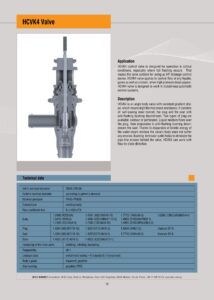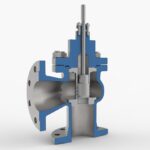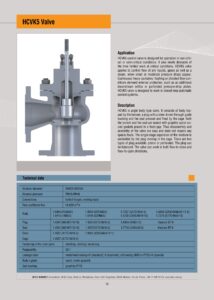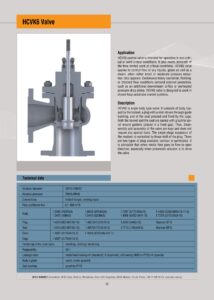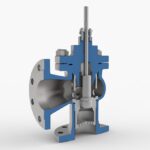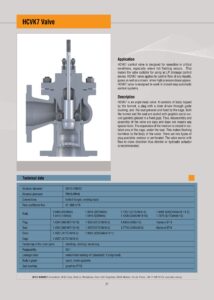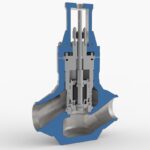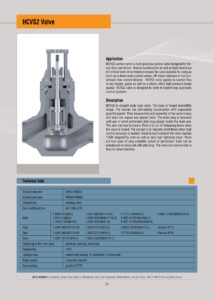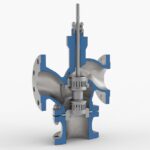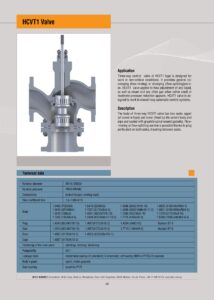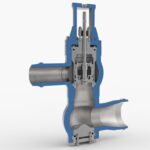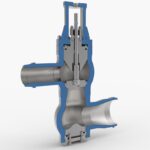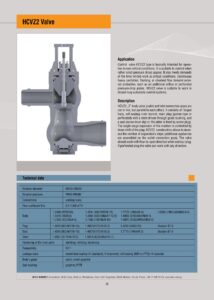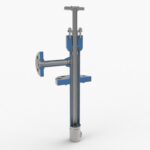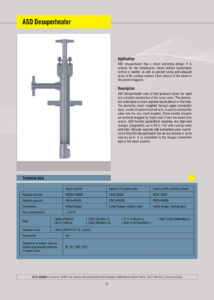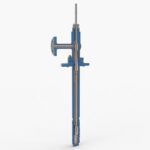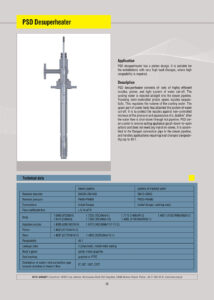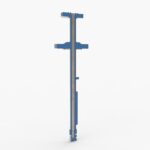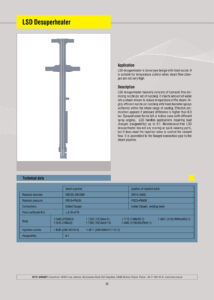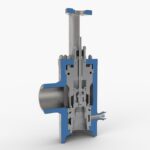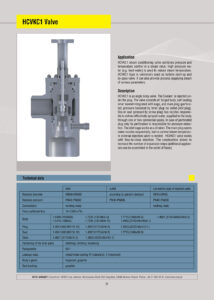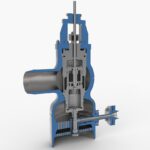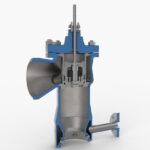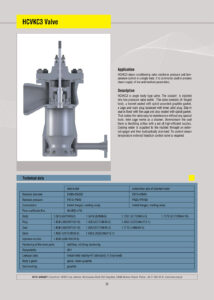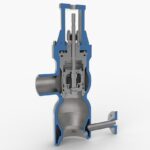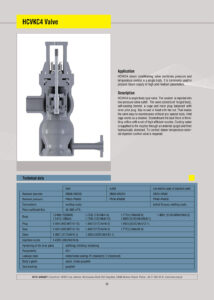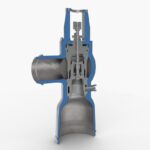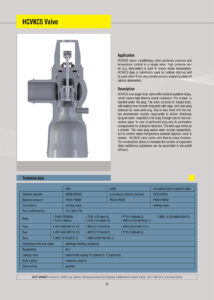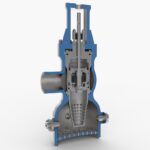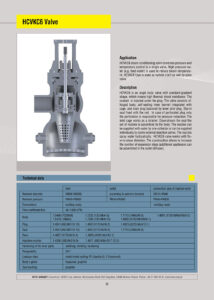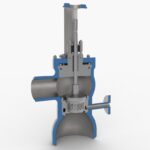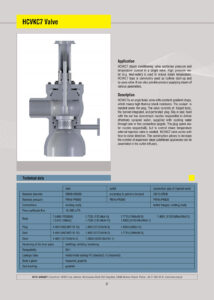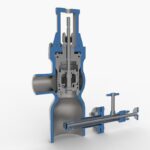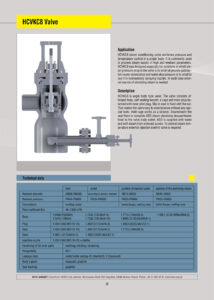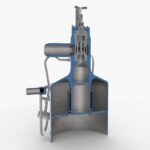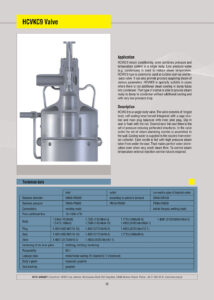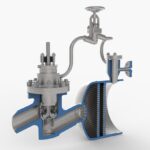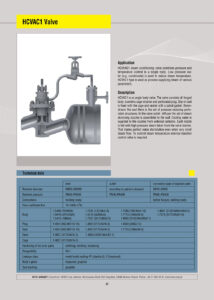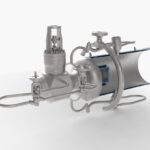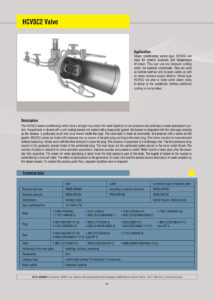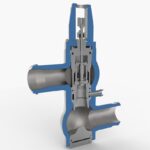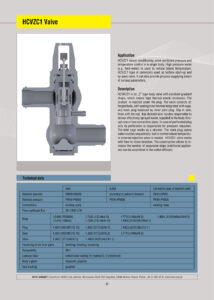CONTROL VALVES
Application:
ECV-type valves are suitable for low erosive media. They are used to control parameters for relatively small pressure drops or in cases of limited operation time under critical conditions. If continuous heavy cavitation, flashing, or throttled flow occurs, external protective devices such as orifices or diffusers should be used. ECV-type valves are often employed as highly precise manual bypass valves.
Description and Principle of Operation:
ECV-type valves are produced as straightway valves. Characteristic elements of these valves include a body with a padded seat and a plug guided in a bushing. The body is topped with a bonnet and sealed with a metal-graphite spiral wound gasket, placed in a channel. The medium is expanded in a single stage through the linear shift of the plug. The plugs are made as either profiled or perforated. It is recommended to install the valves with the flow under the plug, especially for profiled plugs.
Nominal diameter: DN15÷DN300
Nominal pressure: PN10÷PN400
Flow Coefficient Kvs: 0,1÷1300 m3/h
Application:
Regulatory valves of MCV type are suitable for low and medium erosive media only. They are used to control parameters when rather small pressure drops appear. They also meet demands for time-limited work under critical conditions. Continuous heavy cavitation, flashing, or throttled flow call for external protection, such as an orifice or diffuser.
Description and Principle of Operation:
MCV is a straightway valve. Basically, it consists of a body with a screwed-in seat and a plug with a stem driven through a guide bushing. The body is topped by the bonnet and sealed with a graphite spiral wound gasket (placed in a channel). The single-stage expansion of the medium is controlled by the linear shift of the plug. There are two types of plugs available: profiled or perforated. The former is advised when media flow goes under the plug.
Nominal diameter: DN15÷DN300
Nominal pressure: PN10÷PN400
Flow Coefficient Kvs: 0,1÷1300 m3/h
Application:
Regulatory valves of HCVA1 type are suitable for low and medium erosive media. They are used to control highly demanding parameters or for time-limited operation under critical conditions. HCVA1 valves are also used for regulating all types of liquids and steam when small or moderate pressure drops occur. Continuous heavy cavitation, flashing, or throttled flow call for external protection, such as an orifice or diffuser.
Description and Principle of Operation:
HCVA1 is a straightway valve. It consists of a body topped by the bonnet, a plug with a stem driven through a guide bushing, and an insert seat pressed by a construction cage. Both the bonnet and the seat are sealed with metal-graphite spiral wound gaskets, placed in channels. This construction allows for easy disassembly and assembly of the valve without the use of special tools. The single-stage expansion of the medium is controlled by the linear shift of the plug. There are two types of plugs available: profiled or perforated. The former is advised when media flow goes under the plug.
Nominal Diameter: DN15÷DN300
Nominal Pressure: PN10÷PN400
Flow Coefficient (Kvs): 0,1÷1300 m3/h
Application:
Regulatory valves of HCVA2 type are ready to perform with heavy erosive media. They are suitable to control highly demanding parameters, even during continuous operation under critical conditions. HCVA2 valves are ideal for environments with partial cavitation (e.g., injection valves), flashing (e.g., control of condensate levels in regenerative exchangers), or as reducing valves for steam when small or moderate pressure drops occur (e.g., steam pressure reduction in blowers).
Description and Principle of Operation:
HCVA2 is a straightway valve. It consists of a body topped by the bonnet, a plug with a stem driven through a guide bushing, and an insert seat pressed by a throttling cage. Both the bonnet and the seat are sealed with metal-graphite spiral wound gaskets, placed in channels. This construction allows for easy disassembly and assembly of the valve without the use of special tools. The medium undergoes two-step expansion: first through the plug and seat assembly, and then throttled by the cage. There are two types of plugs available: profiled or perforated. HCVA2 valves work with media flow directed under the plug.
Nominal Diameter: DN15÷DN300
Nominal Pressure: PN10÷PN400
Flow Coefficient (Kvs): 0,1÷1300 m3/h
Application:
Regulatory valves of HCVA3 type are ready to perform with heavy erosive media. They are suitable to control highly demanding parameters, even during continuous operation under critical conditions. HCVA3 valves are used as reducing valves for steam when moderate or large pressure drops occur (e.g., steam pressure reduction in blowers).
Description and Principle of Operation:
HCVA3 is a straightway valve. It consists of a body topped by the bonnet, a plug with a stem driven through a guide bushing, and an insert seat pressed by two throttling cages. Both the bonnet and the seat are sealed with metal-graphite spiral wound gaskets, placed in channels. This construction allows for easy disassembly and assembly of the valve without the use of special tools. The medium undergoes three-step expansion: first through the plug and seat assembly, followed by two stages in the passive throttling cages. There are two types of plugs available: profiled or perforated. HCVA3 valves work with media flow directed under the plug.
Nominal Diameter: DN15÷DN300
Nominal Pressure: PN10÷PN400
Flow Coefficient (Kvs): 0,1÷1300 m3/h
Application:
Regulatory valves of HCVA4 type are ready to perform with heavy erosive media. They are suitable to control highly demanding parameters, even during continuous operation under critical conditions. HCVA4 valves are used for continuous desalination of boilers. They are designed to operate in flashing environments and handle high pressure drops.
Description and Principle of Operation:
HCVA4 is a straightway valve. It consists of a body topped by the bonnet, a plug with a stem driven through a guide bushing, and an insert seat with an anti-flashing bushing fixed by a construction cage. Both the bonnet and the seat are sealed with metal-graphite spiral wound gaskets, placed in channels. This construction allows for easy disassembly and assembly of the valve without the use of special tools. The liquid medium reaches the plug and then evaporates in the anti-flashing bushing vents. This disperses the kinetic energy of the water-steam mixture, protecting the valve body from substantial erosion. There are two types of plugs available: profiled or perforated. HCVA4 valves work with media flow directed over the plug.
Nominal Diameter: DN15÷DN300
Nominal Pressure: PN10÷PN400
Flow Coefficient (Kvs): 0,1÷1300 m3/h
Application:
Regulatory valves of HCVB1 type are ready to perform with heavy erosive media. They are suitable to control highly demanding parameters, even during continuous operation under critical conditions. An advantage of these valves is their high coefficient of pressure recovery. They are ideal for applications requiring noise reduction and/or cavitation limitation.
Description and Principle of Operation:
HCVB1 is a straightway valve. It consists of a body topped by the bonnet and an insert seat pressed by a cage, which guides the plug. The bonnet, seat, and cage are all sealed with metal-graphite spiral wound gaskets, placed in channels. This construction allows for easy disassembly and assembly of the valve without the use of special tools. The medium can undergo single-stage expansion (with a piston-type or perforated plug) or two-stage expansion (with a perforated plug). The piston-type plug exposes vents in the active cage, allowing the medium to expand. In the case of perforated plugs, pressure reduction occurs on the perforated section only (single-stage model) or on both the perforated section and in the passive cage (two-stage model). HCVB1 valve plugs can be balanced using a seal, reducing the required actuator power. Valves with a balanced plug provide class IV leakage allowable. HCVB1 valves work with media flow directed either under or over the plug.
Nominal Diameter: DN25÷DN300
Nominal Pressure: PN10÷PN400
Flow Coefficient (Kvs): 0,1÷1300 m3/h
Application:
Regulatory valves of HCVB2 type are ready to perform with heavy erosive media. They are suitable to control highly demanding parameters, even during continuous operation under critical conditions. An advantage of these valves is their high coefficient of pressure recovery. They are ideal for applications requiring noise reduction and/or cavitation limitation.
Description and Principle of Operation:
HCVB2 is a straightway valve. It consists of a body topped by the bonnet and an insert seat fixed by throttling cages: an active cage (which guides the plug) and a passive one. The bonnet, seat, and active cage are all sealed with metal-graphite spiral wound gaskets, placed in channels. This construction allows for easy disassembly and assembly of the valve without the use of special tools. The medium undergoes two-step expansion (with a piston-type plug) or three-step expansion (with a perforated plug). The piston-type plug exposes vents in the active cage, allowing partial expansion of the medium. Further pressure reduction occurs in the vents of the passive cage. The valve with a perforated plug allows for pressure drop allocation first to the plug itself (active stage) and then to the two throttling cages (both passive stages). HCVB2 valve plugs can be balanced using a seal, reducing the required actuator power. Valves with a balanced plug provide class IV leakage allowable. HCVB2 valves work with media flow directed under the plug.
Nominal Diameter: DN25÷DN300
Nominal Pressure: PN10÷PN400
Flow Coefficient (Kvs): 0,1÷1300 m3/h
Application:
Regulatory valves of HCVB3 type are ready to perform with heavy erosive media. They are suitable to control highly demanding parameters, even during continuous operation under critical conditions. An advantage of these valves is their high coefficient of pressure recovery. They are ideal for applications requiring noise reduction and/or cavitation limitation.
Description and Principle of Operation:
HCVB3 is a straightway valve. It consists of a body topped by the bonnet and an insert seat fixed by throttling cages: an active cage (which guides the plug) and two passive ones. The bonnet, seat, and active cage are all sealed with metal-graphite spiral wound gaskets, placed in channels. This construction allows for easy disassembly and assembly of the valve without the use of special tools. The medium undergoes three-step expansion (with a piston-type plug) or four-step expansion (with a perforated plug). The piston-type plug exposes vents in the active cage, allowing partial expansion of the medium. Further pressure reduction occurs in the vents of the two passive cages. The valve with a perforated plug allows for pressure drop allocation first to the plug itself (active stage) and then to the three throttling cages (all passive stages in this case). HCVB3 valve plugs can be balanced using a seal, reducing the required actuator power. Valves with a balanced plug provide class IV leakage allowable. HCVB3 valves work with media flow directed under the plug.
Nominal Diameter: DN25÷DN300
Nominal Pressure: PN10÷PN400
Flow Coefficient (Kvs): 0,1÷1300 m3/h
Application:
Regulatory valves of HCVB4 type are ready to perform with heavy erosive media. They are suitable to control highly demanding parameters, even during continuous operation under critical conditions. An advantage of these valves is their high coefficient of pressure recovery. They are ideal for applications requiring noise reduction and/or cavitation limitation. Additionally, these valves are used when increased tunability and reduced actuator power are required.
Description and Principle of Operation:
HCVB4 is a straightway valve. It consists of a body topped by the bonnet and an insert seat fixed by a cage, which guides a main plug balanced by a pilot plug. The bonnet, seat, and cage are all sealed with metal-graphite spiral wound gaskets, placed in channels. This construction allows for easy disassembly and assembly of the valve without the use of special tools. HCVB4 valves are balanced by the pilot plug working inside the main plug (either perforated or piston-type). The medium undergoes single-stage expansion. Initially, the pilot plug operates, controlling small flows and reducing pressure differences on the main plug, thereby reducing the required actuator power. Once the pilot plug is fully open, the main piston-type plug starts moving, exposing vents in the active cage. In the case of perforated plugs, the pressure drop occurs across the perforated section, while the cage does not add additional resistance. HCVB4 valves work with media flow directed over the plug.
Nominal Diameter: DN50÷DN300
Nominal Pressure: PN10÷PN400
Flow Coefficient (Kvs): 40÷1300 m3/h
Application:
Regulatory valves of HCVB5 type are ready to perform with heavy erosive media. They are suitable to control highly demanding parameters, even during continuous operation under critical conditions. The two-step pressure reduction with intermediate pressure recovery helps to limit cavitation and throttled flow throughout the valve’s full operational range. Due to this feature, HCVB5 valves are often used for controlling condensate flow.
Description and Principle of Operation:
HCVB5 is a straightway valve. It consists of a body topped by the bonnet and an insert seat fixed by a cage, which guides a two-step plug. The bonnet, seat, and cage are all sealed with metal-graphite spiral wound gaskets, placed in channels. This construction allows for easy disassembly and assembly of the valve without the use of special tools. The medium undergoes two-step expansion. Initially, it is throttled by the profiled or perforated part of the plug and then expanded in the vents of the active cage, which are gradually uncovered by the piston-type part of the plug. HCVB5 valves can be balanced using packing, reducing the required actuator power. Valves with balanced plugs provide class IV leakage allowable. HCVB5 valves work with media flow directed under the plug.
Nominal Diameter: DN40÷DN300
Nominal Pressure: PN10÷PN800
Flow Coefficient (Kvs): 6,3÷800 m3/h
Application:
Regulatory valves of HCVB6 type are ready to perform with heavy erosive media. They are suitable to control highly demanding parameters, even during continuous operation under critical conditions. An advantage of these valves is their high coefficient of pressure recovery. They are very useful in applications with significant pressure drops, such as injection valves, pump bypasses, and steam pressure reduction valves.
Description and Principle of Operation:
HCVB6 is a straightway valve. It consists of a body topped by the bonnet and a three-step seat-and-plug unit. The insert seat, tightened by the bonnet, can be made as a single piece or divided. Both the bonnet and the seat are sealed with metal-graphite spiral wound gaskets, placed in channels. This construction allows for easy disassembly and assembly of the valve without the use of special tools. The pressure drop is divided into three stages with pressure recovery between them. The first two stages of the plug are profiled, and the third stage is piston-type. HCVB6 valves work with media flow directed under the plug.
Nominal Diameter: DN15÷DN150
Nominal Pressure: PN10÷PN800
Flow Coefficient (Kvs): 0,1÷125 m3/h
Application:
Regulatory valves of HCVC1 type are suitable for low and medium erosive media. They are used to control any type of liquid, as well as steam when small or moderate pressure drops occur. These valves are also appropriate when the reduction of actuator power is important. Continuous heavy cavitation, flashing, or throttled flow call for external protection, such as an orifice or diffuser.
Description and Principle of Operation:
HCVC1 is a double-seat valve. It consists of a body topped from both sides by bonnets, sealed with metal-graphite spiral wound gaskets, placed in channels. Inside, there are two screwed-in seats and a tandem plug. The incoming medium is divided into two streams, each undergoing single-stage expansion. Before exiting the valve, both streams join together. This design reduces dynamic forces acting on the plug, allowing the selection of a smaller actuator. The plugs are available as either profiled or perforated. The pressure-balanced plug design reduces the required actuator power.
Nominal Diameter: DN50÷DN300
Nominal Pressure: PN10÷PN160
Flow Coefficient (Kvs): 16÷1100 m3/h
Application:
Regulatory valves of HCVD1 type are ready to perform with heavy erosive media. They are suitable to control highly demanding parameters, even during continuous operation under critical conditions. These valves are designed for direct installation in the inlet nozzle of a tank. They are used as control valves for condensate or other near-saturated liquids, operating in environments with flashing or heavy cavitation.
Description and Principle of Operation:
HCVD1 valves have a forged-welded body with a flange that allows for direct installation in the inlet connection pipe of a tank. The piston-type plug operates within a cage attached to the body. The expansion of the medium occurs inside the tank, directing the expanded medium either below or above the liquid surface. This design prevents damage caused by cavitation and flashing, and eliminates erosion problems in the pipeline downstream of the valve. HCVD1 valves are reverse-acting, meaning that pushing the valve stem down closes the valve, and retracting the stem opens it. The valves operate with media flow directed under the plug (flowing towards the opening).
Nominal Diameter: DN50÷DN300
Nominal Pressure: PN10÷PN400
Flow Coefficient (Kvs): 10÷800 m3/h
 https://intec.com.pl/en/wp-content/uploads/2024/06/hcvd1-scaled.jpg
https://intec.com.pl/en/wp-content/uploads/2024/06/hcvd1-scaled.jpg
Application:
Regulatory valves of HCVK1 type are ready to perform with heavy erosive media. They are suitable to control highly demanding parameters, even during continuous operation under critical conditions. An advantage of these valves is their high coefficient of pressure recovery. They are ideal for applications requiring noise reduction and/or cavitation limitation. Additionally, these valves are used when increased tunability and reduced actuator power are required. HCVK1 valves are commonly used as boiler feed and start valves, turbine start and discharge valves, and in installations requiring medium and/or high steam parameter reduction.
Description and Principle of Operation:
HCVK1 is an angle valve. It consists of a forged body, a self-sealing inner bonnet integrated with the cage, and a main plug (either piston-type or perforated), pressure balanced by an inner plug, known as a pilot plug. The valve seat can be either screw-in or slip-in, with the latter being pressed by a screw plug. The medium undergoes single-stage expansion. At the beginning of the valve’s stroke, the pilot plug operates, controlling small flows and reducing pressure differences affecting the main plug, thus reducing the required actuator power. Once the pilot plug is fully open, the main plug starts moving. The piston-type plug opens the vents in the active cage, while in the case of a perforated plug, the pressure reduction occurs only through the perforations, without additional resistance from the cage. HCVK1 valves work with media flow directed over the plug. The construction allows for an increase in the number of pressure reduction stages by adding additional structures in the outlet connection pipe. The valve also has a special version with an unbalanced plug.
Nominal Diameter: DN50÷DN300
Nominal Pressure: PN10÷PN800
Flow Coefficient (Kvs): 10÷1300 m3/h
Application:
Regulatory valves of HCVK2 type are ready to perform with heavy erosive media. They are suitable to control highly demanding parameters, even during continuous operation under critical conditions. An advantage of these valves is their high coefficient of pressure recovery. They are ideal for applications requiring noise reduction and/or cavitation limitation. Additionally, these valves are used when increased tunability and reduced actuator power are required.
Description and Principle of Operation:
The HCVK2 valve has an angular cast body topped by the bonnet. The seat is fixed by a cage that guides a main plug (either piston-type or perforated), which is pressure balanced by an inner plug, known as a pilot plug. The bonnet, seat, and active cage are all sealed with metal-graphite spiral wound gaskets, placed in channels. This construction allows for easy disassembly and assembly of the valve without the use of special tools. The medium undergoes single-stage expansion. At the beginning of the valve’s stroke, the pilot plug operates, controlling small flows and reducing pressure differences on the main plug, thus reducing the required actuator power. Once the pilot plug is fully open, the main plug starts moving. The piston-type plug opens the vents in the active cage, while in the case of a perforated plug, the pressure reduction occurs only through the perforations, without additional resistance from the cage. HCVK2 valves work with media flow directed over the plug.
Nominal Diameter: DN80÷DN250
Nominal Pressure: PN10÷PN40
Flow Coefficient (Kvs): 40÷800 m3/h
Application:
Regulatory valves of HCVK3 type are ready to perform with heavy erosive media. They are suitable to control highly demanding parameters, even during continuous operation under critical conditions. An advantage of these valves is their high coefficient of pressure recovery. They are ideal for applications requiring noise reduction and/or cavitation limitation. Additionally, these valves are used when increased tunability and reduced actuator power are required. HCVK3 valves are often used as boiler feed and start valves, turbine start and discharge valves, and in installations requiring medium and/or high steam parameter reduction.
Description and Principle of Operation:
HCVK3 is an angle valve. Its forged body has walls of equal thickness, which reduces thermal stresses during the valve’s warming up and cooling. The self-sealing inner bonnet is integrated with the cage, which guides a main plug (either piston-type or perforated), pressure balanced by an inner plug known as a pilot plug. The valve seat can be either screw-in or slip-in, with the latter being pressed by a screw plug. The medium undergoes single-stage expansion. At the beginning of the valve’s stroke, the pilot plug operates, controlling small flows and reducing pressure differences affecting the main plug, thus reducing the required actuator power. Once the pilot plug is fully open, the main plug starts moving. The piston-type plug opens the vents in the active cage, while in the case of a perforated plug, the pressure reduction occurs only through the perforations, without additional resistance from the cage. HCVK3 valves work with media flow directed over the plug. The construction allows for an increase in the number of pressure reduction stages by adding additional structures in the outlet connection pipe. The valve also has a special version with an unbalanced plug.
Nominal Diameter: DN50÷DN300
Nominal Pressure: PN40÷PN800
Flow Coefficient (Kvs): 10÷1300 m3/h
Application:
Regulatory valves of HCVK4 type are ready to perform with heavy erosive media. They are suitable to control highly demanding parameters, even during continuous operation under critical conditions. HCVK4 valves are used for continuous desalination of boilers. Their performance suits environments with flashing and high-pressure drops.
Description and Principle of Operation:
HCVK4 is an angle valve with a forged body. It consists of a self-sealing inner bonnet, a plug with a bushing, and a seat with an anti-flashing bushing. The seat can be either screw-in or slip-in, with the latter being pressed by a screw plug. A liquid medium flows over the plug and then evaporates in the vents of the anti-flashing bushing. This design disperses the kinetic energy of the water-steam mixture, preventing substantial erosion of the valve body. The lenticular shape of the bushing’s outlet helps protect the downstream pipeline from erosion. There are two types of plugs available: profiled or perforated. HCVK4 valves work with media flow directed over the plug.
Nominal Diameter: DN50÷DN300
Nominal Pressure: PN40÷PN800
Flow Coefficient (Kvs): 10÷160 m3/h
Application:
Regulatory valves of HCVK5 type are ready to perform with heavy erosive media. They are suitable to control highly demanding parameters, even during continuous operation under critical conditions. An advantage of these valves is their high coefficient of pressure recovery. They are ideal for applications requiring noise reduction and/or cavitation limitation.
Description and Principle of Operation:
The HCVK5 valve has an angular cast body topped by the bonnet. The slip-in seat is fixed by a cage that guides the main plug. Both the bonnet and seat, as well as the cage, are sealed with metal-graphite spiral wound gaskets, placed in channels. This construction allows for easy disassembly and assembly of the valve without the use of special tools. The medium may undergo single-stage expansion (when the valve plug is perforated or piston-type) or two-step expansion (when a perforated plug is employed). If the piston-type plug opens the vents in the active cage, single-stage expansion occurs. The same happens if only the perforation of the plug is responsible for pressure reduction. When a passive cage is also used, two-step expansion occurs. HCVK5 valves may have seal-balanced plugs, allowing for the selection of a smaller actuator while maintaining class IV leakage allowable. HCVK5 valves work with media flow directed either over or under the plug.
Nominal Diameter: DN25÷DN250
Nominal Pressure: PN10÷PN40
Flow Coefficient (Kvs): 10÷800 m3/h
Application:
Regulatory valves of HCVK6 type are suitable for low and medium erosive media. They are used to control highly demanding parameters and also meet the requirements for time-limited work under critical conditions. HCVK6 valves are applicable for adjusting the flow of any liquid, as well as steam, when small or moderate pressure drops occur. Continuous heavy cavitation, flashing, or throttled flow call for external protection, such as an orifice or diffuser.
Description and Principle of Operation:
HCVK6 valves have an angular cast body topped by the bonnet. The slip-in seat is fixed by a construction cage, and the main plug is guided by its own bushing. Both the bonnet and seat are sealed with metal-graphite spiral wound gaskets, placed in channels. This construction allows for easy disassembly and assembly of the valve without the use of special tools. The medium undergoes single-stage expansion controlled by the linear shift of the plug. There are two types of plugs available: profiled or perforated. The former is recommended when the media flow goes under the plug.
Nominal Diameter: DN25÷DN250
Nominal Pressure: PN10÷PN40
Flow Coefficient (Kvs): 10÷800 m3/h
Application:
Regulatory valves of HCVK7 type are ready to perform with heavy erosive media. They are suitable to control highly demanding parameters, even during continuous operation under critical conditions. These valves are also designed to work in environments with flashing and high-pressure drops.
Description and Principle of Operation:
The HCVK7 valve is an angular valve. It consists of a cast body topped by the bonnet, a plug with a stem driven through a guide bushing, and a slip-in seat with an anti-flashing bushing fixed by a construction cage. Both the bonnet and seat are sealed with metal-graphite spiral wound gaskets, placed in channels. This construction allows for easy disassembly and assembly of the valve without the use of special tools. The liquid medium flows over the plug and then evaporates in the anti-flashing bushing vents. This design disperses the kinetic energy of the water-steam mixture, preventing substantial erosion of the valve body. The lenticular shape of the bushing’s outlet helps protect the downstream pipeline from erosion. There are two types of plugs available: profiled or perforated. HCVK7 valves work with media flow directed over the plug.
Nominal Diameter: DN15÷DN250
Nominal Pressure: PN10÷PN40
Flow Coefficient (Kvs): 10÷800 m3/h
Application:
HCVK8 valves are suitable for severe erosive conditions. They are designed to regulate highly demanding parameters, even during continuous operation under critical conditions. These valves feature a high coefficient of pressure recovery, making them ideal for applications with significant pressure drops, such as injection valves, pump bypasses, and steam pressure reduction valves.
Description and Principle of Operation:
HCVK8 is an angle valve. It consists of a body enclosed by a bonnet and a three-step seat-and-plug unit. The insert seat, tightened by the bonnet, can be constructed as a single piece or divided. Both the bonnet and the seat are sealed with metal-graphite spiral wound gaskets, placed in channels. This construction allows for easy disassembly and assembly of the valve without the use of special tools. The pressure drop is divided into three stages with pressure recovery between them. The first two stages of the plug are profiled, and the third stage is piston-type. HCVK8 valves operate with the media flow directed under the plug.
Nominal Diameter: DN15÷DN150
Nominal Pressure: PN10÷PN400
Flow Coefficient (Kvs): 0.1÷125 m³/h
Application:
Regulatory valves of HCVS2 type are ready to perform with heavy erosive media. They are suitable to control highly demanding parameters, even during continuous operation under critical conditions. An advantage of these valves is their high coefficient of pressure recovery. They are ideal for applications requiring noise reduction and/or cavitation limitation. Additionally, these valves are used when increased tunability and reduced actuator power are required. HCVS2 valves are most often used as boiler feed and start valves, turbine start and discharge valves, and in installations requiring medium and/or high steam parameter reduction.
Description and Principle of Operation:
HCVS2 is a straightway valve. It consists of a forged body with a self-sealing inner bonnet integrated with the cage, and a main plug (either piston-type or perforated), pressure balanced by an inner plug known as a pilot plug. The valve seat can be either screw-in or slip-in, with the latter being pressed by a screw plug. The medium undergoes single-stage expansion. At the beginning of the valve’s stroke, the pilot plug operates, controlling small flows and reducing pressure differences affecting the main plug, thus reducing the required actuator power. Once the pilot plug is fully open, the main plug starts moving. The piston-type plug opens the vents in the active cage, while in the case of a perforated plug, the pressure reduction occurs only through the perforations, without additional resistance from the cage. HCVS2 valves work with media flow directed over the plug.
Nominal Diameter: DN15÷DN300
Nominal Pressure: PN250÷PN800
Flow Coefficient (Kvs): 40÷800 m3/h
Application:
Regulatory valves of HCVS6 type are ready to perform with heavy erosive media. They are suitable to control highly demanding parameters, even during continuous operation under critical conditions. HCVS6 valves have a high coefficient of pressure recovery and are used in applications with significant pressure drops, such as injection valves, pump bypasses, and steam reducing valves.
Description and Principle of Operation:
HCVS6 is a straightway valve. It consists of a forged body and a three-stage seat-and-plug assembly. The lower part of the body contains a cover sealed with a trapezoidal gasket, which is used for mounting the active components. The seat is slip-in and pressed by a screw plug. The pressure drop is divided into three stages with pressure recovery between them. The first two stages of the plug are profiled, and the third stage is piston-type. HCVS6 valves work with media flow directed under the plug.
Nominal Diameter: DN25÷DN150
Nominal Pressure: PN40÷PN800
Flow Coefficient (Kvs): 0,1÷125 m3/h
Application:
Three-way valves of HCVT1 type are suitable for low and medium erosive media. They provide general converging (flow-mixing) or diverging (flow-splitting) service. HCVT1 valves are used for flow adjustment of any liquid, as well as steam and any other gas when small or moderate pressure drops occur. Continuous heavy cavitation, flashing, or throttled flow call for external protection, such as an orifice or diffuser.
Description and Principle of Operation:
The body of the three-way HCVT1 valve has two seats: an upper screw-in type and a lower seat squeezed between the valve body and the pipe, sealed with metal-graphite spiral wound gaskets. Flow-mixing or flow-splitting service is achieved by a plug perforated on both sides, traveling between the seats. The inlet and outlet connection pipes have clearly marked flow directions.
Nominal Diameter: DN15÷DN300
Nominal Pressure: PN10÷PN800
Flow Coefficient (Kvs): 1,6÷1300 m3/h
Application:
Regulatory valves of HCVZ1 type are ready to perform with heavy erosive media. They are suitable to control highly demanding parameters, even during continuous operation under critical conditions. An advantage of these valves is their high coefficient of pressure recovery. They are ideal for applications requiring noise reduction and/or cavitation limitation. Additionally, these valves are used when increased tunability and reduced actuator power are required. HCVZ1 valves are most often used as boiler feed and start valves, turbine start and discharge valves, and in installations requiring medium and/or high steam parameter reduction.
Description and Principle of Operation:
HCVZ1 is a so-called Z-type valve (outlet and inlet connection pipes are not in line, but parallel to each other). It consists of a forged body, a self-sealing inner bonnet integrated with the cage, and a main plug (either piston-type or perforated), pressure balanced by an inner plug known as a pilot plug. The valve seat can be either screw-in or slip-in, with the latter being pressed by a screw plug. The medium undergoes single-stage expansion. At the beginning of the valve’s stroke, the pilot plug operates, controlling small flows and reducing pressure differences affecting the main plug, thus reducing the required actuator power. Once the pilot plug is fully open, the main plug starts moving. The piston-type plug opens the vents in the active cage, while in the case of a perforated plug, the pressure reduction occurs only through the perforations, without additional resistance from the cage. HCVZ1 valves work with media flow directed over the plug. The construction allows for an increase in the number of pressure reduction stages by adding additional structures in the outlet connection pipe. The valve also has a special version with an unbalanced plug.
Nominal Diameter: DN50÷DN300
Nominal Pressure: PN40÷PN800
Flow Coefficient (Kvs): 10÷1300 m3/h
Application:
Regulatory valves of HCVZ2 type are suitable for low and medium erosive media. They are used to control highly demanding parameters and also meet the requirements for time-limited work under critical conditions. HCVZ2 valves are applicable for adjusting the flow of any liquid, as well as steam, when small or moderate pressure drops occur. Continuous heavy cavitation, flashing, or throttled flow call for external protection, such as an orifice or diffuser.
Description and Principle of Operation:
HCVZ2 is a so-called Z-type valve (outlet and inlet connection pipes are not in line, but parallel to each other). It consists of a forged body, a self-sealing inner bonnet, a main plug (either piston-type or perforated) with a stem driven through a guide bushing, and a seat (either screw-in or slip-in, with the latter being pressed by a screw plug). The single-stage expansion of the medium is controlled by the linear shift of the plug. When the media flow goes under the plug, a valve with a profiled plug is recommended. HCVZ2’s construction allows for an increase in the number of pressure reduction stages by adding additional structures in the outlet connection pipe.
Nominal Diameter: DN25÷DN300
Nominal Pressure: PN40÷PN800
Flow Coefficient (Kvs): 0,1÷1300 m3/h
DESUPERHEATERS AND STEAM CONDITIONING STATIONS
Application:
ASD desuperheaters with steam atomization are used in steam temperature control systems where high precision and effective cooling medium atomization are required, especially at low steam velocities in the pipeline.
Description and Principle of Operation:
ASD desuperheaters are equipped with steam atomization nozzles. Cooling is achieved by directly injecting cooling water into the steam. In the injection nozzle located in the desuperheater head, water droplets are atomized by the impact of a supercritical velocity steam jet. The result is the creation of a water mist and almost immediate absorption of the water by the steam flow. The maximum effective rangeability of the desuperheater, measured as the ratio of the maximum to the minimum cooled steam flow, is 60:1. ASD desuperheaters are maintenance-free, having no moving or rapidly wearing parts. They are mounted to a flanged connection on the steam pipeline. Cooling water is supplied through a side connection, while atomizing steam is supplied through the top connection.
To regulate the flow of cooling water, an additional injection valve is required. The flow of steam needed for atomization is constant and does not require smooth regulation. It is limited using an orifice or a manual throttling valve.
Technical data:
Steam Pipeline:
Nominal diameter: DN200÷DN600
Nominal pressure: PN10÷PN400
Flow coefficient (Kvs): ≥ 1 m3/h
Cooling Water Pipeline:
Nominal diameter: DN15÷DN50
Nominal pressure: PN25÷PN400
Flow coefficient (Kvs): ≥ 1 m3/h
Atomizing Steam Pipeline:
Nominal diameter: DN15÷DN50
Nominal pressure: PN25÷PN400
Flow coefficient (Kvs): ≥ 1 m3/h
Application:
PSD desuperheaters with a piston design are used in steam temperature control systems with significant load changes. They are especially recommended for applications with high variability in the temperature of the cooled medium or the pressure of the cooling medium.
Description and Principle of Operation:
PSD desuperheaters consist of sets of highly efficient nozzles, a piston, and a tight water cutoff system. Cooling is achieved by directly injecting cooling water into the steam pipeline. The piston, controlled by a traveling stem, regulates the flow by sequentially opening the nozzles. The water cutoff system located at the top of the cooler’s body protects the injection system from uncontrolled pressure increases and the formation of a „bubble” after the flow of the medium is shut off in a hot pipeline.
PSD desuperheaters are reverse-acting devices (push-down-to-open action). Extending the stem closes the desuperheater, while retracting the stem opens it. The maximum effective rangeability of the desuperheater, measured as the ratio of the maximum to the minimum cooled steam flow, is 40:1. PSD desuperheaters are mounted to a flanged connection on the steam pipeline and do not require the use of injection valves.
Technical data:
Steam Pipeline:
Nominal diameter: DN200÷DN1000
Nominal pressure: PN40÷PN400
Flow coefficient (Kvs): ≥ 0,16 m3/h
Cooling Water Pipeline:
Nominal diameter: DN15÷DN50
Nominal pressure: PN25÷PN400
Flow coefficient (Kvs): ≥ 0,16 m3/h
Application:
LSD desuperheaters with a lance design are used in steam temperature control systems with small load changes.
Description and Principle of Operation:
LSD desuperheaters are equipped with hydraulic fine atomizing nozzles. Cooling is achieved by directly injecting cooling water into the steam pipeline. Highly efficient nozzles with fixed diameters ensure optimal atomization and uniform distribution of the spray across the entire operating range. Effective atomization occurs with a pressure difference as low as 0.3 bar. Depending on the cooling process parameters, the desuperheater can be equipped with one or several nozzles. The water sprayed by the nozzles forms a full or hollow cone with various spray angles. The maximum effective rangeability of the desuperheater, measured as the ratio of the maximum to the minimum cooled steam flow, is 6:1. LSD desuperheaters are completely maintenance-free, with no moving or rapidly wearing parts. They are mounted to a flanged connection on the steam pipeline. An injection valve is additionally required to regulate the flow of cooling water.
Technical data:
Steam Pipeline:
Nominal diameter: DN150÷DN1000
Nominal pressure: PN10÷PN400
Flow coefficient (Kvs): ≥ 0,16 m3/h
Cooling Water Pipeline:
Nominal diameter: DN15÷DN50
Nominal pressure: PN25÷PN400
Flow coefficient (Kvs): ≥ 0,16 m3/h
Application:
RSD desuperheaters with a ring design are used in steam temperature control systems with moderate load changes.
Description and Principle of Operation:
RSD desuperheaters consist of hydraulic fine atomizing nozzles. They inject water into the steam flow to lower the steam temperature. Highly efficient nozzles spray water at the outlet of a specially profiled convergent section, which accelerates the steam and induces turbulence. This design increases the rangeability of the desuperheater. RSD handles applications requiring load changes up to 20:1. The maintenance-free desuperheater has no moving or quickly wearing parts. An injection valve is required to control the flow of cooling water. Typically, the RSD desuperheater is installed between two flanges of the steam pipeline, but it can also be made with welded connections.
Technical data:
Steam Pipeline:
Nominal diameter: DN25÷DN250
Nominal pressure: PN10÷PN400
Flow coefficient (Kvs): ≥ 0,08 m3/h
Cooling Water Pipeline:
Nominal diameter: DN25÷DN50
Nominal pressure: PN25÷PN400
Flow coefficient (Kvs): ≥ 0,08 m3/h
Application:
HCVKC1 steam conditioning valves combine pressure and temperature control in a single valve. Temperature reduction is achieved through high-pressure water injection (e.g., feedwater). HCVKC1 valves are commonly used as turbine start or discharge valves.
Description and Principle of Operation:
HCVKC1 is an angle valve. Coolant, i.e., water, is injected under the plug. The valve consists of a forged body, a self-sealing inner bonnet integrated with the cage, and a main plug (perforated, pressure balanced by an inner plug known as a pilot plug). The slip-in seat, pressed by a screw plug, contains nozzles that ensure adequate water spray, supplied to the body through one or two connection pipes. The medium undergoes single-stage expansion. In the case of a perforated plug, only its perforations are responsible for pressure reduction; the cage does not contribute. The main plug sequentially opens the water nozzles, while the pilot plug only serves to balance the pressure. HCVKC1 valves work with media flow directed over the plug. Their construction allows for an increase in the number of pressure reduction stages by adding additional structures in the outlet connection pipe. Control of the coolant flow requires the implementation of an additional injection valve. HCVKC1 valves also have a special version with an unbalanced plug.
Technical data:
Inlet:
Nominal diameter: DN50÷DN300
Nominal pressure: PN40÷PN800
Flow coefficient (Kvs): 10÷1300 m3/h
Outlet:
Nominal diameter: according to customer requirements
Nominal pressure: PN16÷PN800
Flow coefficient (Kvs): 10÷1300 m3/h
Injection water:
Nominal diameter: DN15÷DN50
Nominal pressure: PN40÷PN800
Flow coefficient (Kvs): 10÷1300 m3/h
Application:
HCVKC2 steam conditioning valves combine pressure and temperature control in a single valve. Temperature reduction is achieved through water injection under low-pressure conditions (condensate can be administered). HCVKC2 valves are commonly used as turbine start or discharge valves and in process steam systems.
Description and Principle of Operation:
HCVKC2 is an angle valve. It incorporates a spray water manifold and atomizing steam implementation downstream of its pressure reduction stage. The valve consists of a forged body, a self-sealing inner bonnet integrated with the cage, and a main plug (perforated, pressure balanced by an inner plug known as a pilot plug). Two types of seats are available: screw-in or slip-in (the latter is pressed by a screw plug). The lower part of the seat has a perforated throttling bushing and an atomizing steam nozzle.
The medium undergoes multi-step expansion. Initially, the expansion occurs in the vents of the perforated throttling bushing of the seat, which open sequentially as the plug moves. Further expansion is achieved by throttling plates fixed at the valve’s outlet. The number of plates corresponds to the valve’s specified operating characteristics. Water injection follows the complete steam expansion. Atomizing steam reaches the nozzles during the first stage of the valve’s opening, producing smaller droplets that remain suspended and are almost immediately absorbed by the steam stream. HCVKC2 valves work with media flow directed over the plug. Controlling the coolant flow requires the implementation of an additional injection valve. HCVKC2 valves also have a special version with an unbalanced plug.
Technical data:
Inlet:
Nominal diameter: DN50÷DN300
Nominal pressure: PN40÷PN800
Flow coefficient (Kvs): 10÷1300 m3/h
Outlet:
Nominal diameter: according to customer requirements
Nominal pressure: PN16÷PN800
Flow coefficient (Kvs): 10÷1300 m3/h
Injection water:
Nominal diameter: DN15÷DN50
Nominal pressure: PN40÷PN800
Flow coefficient (Kvs): 10÷1300 m3/h
Application:
HCVKC3 steam conditioning valves combine pressure and temperature control in a single valve and are commonly used in process steam systems.
Description and Principle of Operation:
HCVKC3 is an angle valve. It incorporates a highly effective spray water manifold downstream of its pressure reduction stage, at the valve’s convergent cone placed in the outlet connection pipe. This cone is purposely profiled to accelerate the steam to be cooled and initialize its turbulent flow. This design increases fine-tuning capability and supports water uptake even at low steam velocities.
The valve consists of a body topped by the bonnet, a main plug (either piston-type or perforated, pressure balanced by an inner plug known as a pilot plug), and a seat fixed by an active cage that guides the main plug. Both the bonnet and the seat, as well as the active cage, are sealed with graphite spiral wound gaskets, placed in channels. This construction allows for easy disassembly and assembly of the valve without the use of special tools.
At the beginning of the valve’s stroke, the pilot plug operates, controlling small flows and reducing pressure differences affecting the main plug. The reduced dynamic forces acting on the main plug might permit choosing a smaller actuator. Once the pilot plug is fully open, the main plug starts moving. The piston-type plug opens the vents in the active cage, while in the case of a perforated plug, the pressure reduction occurs only through the perforations, without additional resistance from the cage. HCVKC3 valves work with media flow directed over the plug. Controlling the coolant flow requires the implementation of an additional injection valve.
Technical data:
Inlet:
Nominal diameter: DN50÷DN300
Nominal pressure: PN10÷PN40
Flow coefficient (Kvs): 10÷1300 m3/h
Outlet:
Nominal diameter: according to customer requirements
Nominal pressure: PN16÷PN40
Flow coefficient (Kvs): 10÷1300 m3/h
Injection water:
Nominal diameter: DN15÷DN50
Nominal pressure: PN40÷PN800
Flow coefficient (Kvs): 10÷1300 m3/h
Application:
HCVKC4 steam conditioning valves combine pressure and temperature control in a single valve and are commonly used in process steam systems.
Description and Principle of Operation:
HCVKC4 is an angle valve. It incorporates a highly effective spray water manifold downstream of its pressure reduction stage, at the valve’s convergent cone placed in the outlet connection pipe. This cone is purposely profiled to accelerate the steam to be cooled and initialize its turbulent flow. This design increases fine-tuning capability and supports water uptake even at low steam velocities.
The valve consists of a body, a self-sealing inner bonnet integrated with the cage, a main plug (either piston-type or perforated, pressure balanced by an inner plug known as a pilot plug), and a seat. Two types of seats are available: screw-in or slip-in (the latter is pressed by a screw plug). At the beginning of the valve’s stroke, the pilot plug operates, controlling small flows and reducing pressure differences affecting the main plug. The reduced dynamic forces acting on the main plug might permit choosing a smaller actuator. Once the pilot plug is fully open, the main plug starts moving. The piston-type plug opens the vents in the active cage, while in the case of a perforated plug, the pressure reduction occurs only through the perforations, without additional resistance from the cage. HCVKC4 valves work with media flow directed over the plug. Controlling the coolant flow requires the implementation of an additional injection valve.
Technical data:
Inlet:
Nominal diameter: DN50÷DN300
Nominal pressure: PN40÷PN800
Flow coefficient (Kvs): 10÷1300 m3/h
Outlet:
Nominal diameter: according to customer requirements
Nominal pressure: PN16÷PN800
Flow coefficient (Kvs): 10÷1300 m3/h
Injection water:
Nominal diameter: DN15÷DN50
Nominal pressure: PN40÷PN800
Flow coefficient (Kvs): 10÷1300 m3/h
Application:
HCVKC5 steam conditioning valves combine pressure and temperature control in a single valve. Temperature reduction is achieved through high-pressure water injection (e.g., feedwater). HCVKC5 valves are commonly used as turbine start or discharge valves.
Description and Principle of Operation:
HCVKC5 is an angle valve. Coolant, i.e., water, is injected under the plug. The forged body of the valve has equal wall thickness, which reduces thermal stresses during valve warming up and cooling. The valve consists of a body, a self-sealing inner bonnet integrated with the cage, a main plug (perforated, pressure balanced by an inner plug known as a pilot plug), and a slip-in seat pressed by a screw plug. The cage drives the main plug. The seat has nozzles responsible for delivering adequately sprayed water, supplied to the body through one or two connection pipes. The medium undergoes single-stage expansion. In the case of a perforated plug, only its perforations are responsible for pressure reduction; the cage does not contribute. The main plug also sequentially opens the water nozzles, while the pilot plug only serves to balance the pressure. HCVKC5 valves work with media flow directed over the plug. Their construction allows for an increase in the number of pressure reduction stages by adding additional structures in the outlet pipe. Controlling the coolant flow requires the implementation of an additional injection valve. HCVKC5 valves also have a special version with an unbalanced plug.
Technical data:
Inlet:
Nominal diameter: DN50÷DN300
Nominal pressure: PN10÷PN800
Flow coefficient (Kvs): 10÷1300 m3/h
Outlet:
Nominal diameter: according to customer requirements
Nominal pressure: PN16÷PN40
Flow coefficient (Kvs): 10÷1300 m3/h
Injection water:
Nominal diameter: DN15÷DN50
Nominal pressure: PN40÷PN800
Flow coefficient (Kvs): 10÷1300 m3/h
Application:
HCVKC6 steam conditioning valves combine pressure and temperature control in a single valve. They are commonly used as turbine start or discharge valves.
Description and Principle of Operation:
HCVKC6 is an angle valve. The cooling water is delivered by a set of highly efficient nozzles assembled in a spray chamber under the valve’s seat. The forged body of the valve has equal wall thickness, which reduces thermal stresses during valve warming up and cooling. The valve consists of a body, a self-sealing inner bonnet integrated with the cage, a main plug (either perforated or piston-type, pressure balanced by an inner plug known as a pilot plug), and a slip-in seat pressed by a screw plug. The cage drives the main plug, and the seat has a perforated throttling device on its outlet.
At the beginning of the valve’s stroke, the pilot plug operates, controlling small flows and reducing pressure differences affecting the main plug. The reduced dynamic forces acting on the main plug might permit choosing a smaller actuator. Once the pilot plug is fully open, the main plug starts moving. The piston-type plug opens the vents in the active cage, while in the case of a perforated plug, the pressure reduction occurs only through the perforations, without additional resistance from the cage. HCVKC6 valves work with media flow directed over the plug.
The medium undergoes multi-step expansion. Initially, the expansion occurs on the plug itself (active stage). The next two steps (passive stages) occur at the seat’s perforation and on the throttling plate. The valve’s construction allows for an increase in the number of pressure reduction stages by adding additional structures in the outlet connection pipe. Controlling the coolant flow requires the implementation of an additional injection valve.
Technical data:
Inlet:
Nominal diameter: DN50÷DN300
Nominal pressure: PN40÷PN800
Flow coefficient (Kvs): 10÷1300 m3/h
Outlet:
Nominal diameter: according to customer requirements
Nominal pressure: PN16÷PN800
Flow coefficient (Kvs): 10÷1300 m3/h
Injection water:
Nominal diameter: DN15÷DN50
Nominal pressure: PN40÷PN800
Flow coefficient (Kvs): 10÷1300 m3/h
Application:
HCVKC7 steam conditioning valves combine pressure and temperature control in a single valve and are commonly used in process steam systems where a high level of tuning is of extreme importance.
Description and Principle of Operation:
HCVKC7 is an angle valve. It incorporates a spray water manifold and atomizing steam implementation downstream of its pressure reduction stage. The forged body has a self-sealing inner bonnet with a trapezoid gasket. The slip-in seat, pressed by a screw plug, has injection nozzles in its lower part. These nozzles use steam from the high-pressure portion of the valve to atomize the water droplets. This atomization creates smaller droplets, allowing for immediate absorption by the steam stream, and helps the water remain suspended.
Water injection occurs away from the valve’s moving parts, significantly increasing the valve’s lifespan. The medium undergoes single-stage expansion through a perforated plug. During the initial valve opening, the atomizing steam reaches the nozzles. HCVKC7 valves work with media flow directed over the plug. Their construction allows for an increase in the number of pressure reduction stages by adding additional structures in the outlet connection pipe. Controlling the coolant flow requires the implementation of an additional injection valve.
Technical data:
Inlet:
Nominal diameter: DN50÷DN300
Nominal pressure: PN40÷PN800
Flow coefficient (Kvs): 10÷1300 m3/h
Outlet:
Nominal diameter: according to customer requirements
Nominal pressure: PN16÷PN800
Flow coefficient (Kvs): 10÷1300 m3/h
Injection water:
Nominal diameter: DN15÷DN50
Nominal pressure: PN40÷PN800
Flow coefficient (Kvs): 10÷1300 m3/h
Application:
HCVKC8 steam conditioning valves combine pressure and temperature control in a single valve. Temperature reduction is achieved through water injection under low-pressure conditions (a condensate can be administered). HCVKC8 valves are commonly used as turbine start or discharge valves and in process steam systems.
Description and Principle of Operation:
HCVKC8 is an angle valve. It incorporates a steam cooler (ASD desuperheater) downstream of its pressure reduction stage. The valve consists of a forged body, a self-sealing inner bonnet integrated with the cage, a main plug (perforated or profiled, pressure balanced by an inner plug known as a pilot plug), and a seat. Two types of seats are available: screw-in or slip-in (the latter is pressed by a screw plug). The cage drives the main plug. HCVKC8 valves work with media flow directed over the plug.
At the beginning of the valve’s stroke, the pilot plug operates, controlling small flows and reducing pressure differences affecting the main plug. The reduced dynamic forces acting on the main plug might permit choosing a smaller actuator. Once the pilot plug is fully open, the main plug starts moving. The piston-type plug opens the vents in the active cage, while in the case of a perforated plug, the pressure reduction occurs only through the perforations, without additional resistance from the cage.
The valve’s construction allows for an increase in the number of pressure reduction stages by adding additional structures in the outlet connection pipe. Water injection follows the complete steam expansion. The steam cooler can be fed through the valve vent or externally. Water atomized into very small droplets remains suspended and is almost immediately absorbed by the steam’s stream. Controlling the coolant flow requires the implementation of an additional injection valve. However, the steam feeding the cooler does not need smooth and steady control. Its stream has a constant volume, easily regulated by means of an orifice or manual throttling valve.
Technical data:
Inlet:
Nominal diameter: DN50÷DN300
Nominal pressure: PN40÷PN800
Flow coefficient (Kvs): 10÷1300 m3/h
Outlet:
Nominal diameter: according to customer requirements
Nominal pressure: PN16÷PN800
Flow coefficient (Kvs): 10÷1300 m3/h
Injection water:
Nominal diameter: DN15÷DN50
Nominal pressure: PN40÷PN800
Flow coefficient (Kvs): 10÷1300 m3/h
Steam atomization pipeline:
Nominal diameter: DN15÷DN50
Nominal pressure: PN25÷PN800
Flow coefficient (Kvs): 40÷1300 m3/h
Application:
HCVKC9 steam conditioning valves combine pressure and temperature control in a single valve. They can utilize low-pressure water (e.g., condensate) for cooling. These valves are commonly used as turbine start or discharge valves and are designed to work with condensers without the need for additional steam cooling in dump tubes.
Description and Principle of Operation:
HCVKC9 is an angle valve with downstream water injection and steam atomization. The valve consists of a forged body, a self-sealing inner bonnet integrated with the cage, and a main plug (perforated, pressure balanced by an inner plug known as a pilot plug). The slip-in seat, pressed by a screw plug, features channels for steam uptake necessary for atomization. Injection nozzles are located in the outlet connection pipe. HCVKC9 valves work with media flow directed over the plug.
The medium undergoes multistep expansion. The initial pressure drop occurs through the gradually opening vents of the perforated plug. Subsequent pressure reduction stages are managed by throttling plates located in the outlet throat of the valve, with the number of plates tailored to the valve’s operating parameters. Water injection occurs after the steam has fully expanded. During the initial valve opening, the nozzles are supplied with atomizing steam, producing a fine mist that is rapidly absorbed by the steam flow.
To regulate the flow of cooling water, an additional injection valve is required. The atomizing steam flow does not require continuous adjustment and can be controlled by an orifice or a manual throttling valve. HCVKC9 valves also have a special version with an unbalanced plug.
Technical data:
Inlet:
Nominal diameter: DN50÷DN300
Nominal pressure: PN40÷PN800
Flow coefficient (Kvs): 10÷1300 m3/h
Outlet:
Nominal diameter: according to customer requirements
Nominal pressure: PN16÷PN800
Flow coefficient (Kvs): 10÷1300 m3/h
Injection water:
Nominal diameter: DN15÷DN50
Nominal pressure: PN40÷PN800
Flow coefficient (Kvs): 10÷1300 m3/h
Application:
HCVAC1 steam conditioning valves combine pressure and temperature control in a single valve and are commonly used in process steam systems.
Description and Principle of Operation:
HCVAC1 is a straightway valve with downstream water injection and steam atomization. The pressure-reducing section is based on regulatory valves featuring a perforated plug guided by a bushing and a slip-in seat fixed by a construction cage. The medium undergoes multistep expansion. The initial stage occurs through the perforated plug, followed by further pressure reduction via throttling plates located in the valve’s outlet throat. The number of plates is tailored to the valve’s operating parameters.
Water injection occurs after the steam has fully expanded. Atomizing steam is drawn from the high-pressure space through the stem of the plug. This results in the formation of a fine mist, allowing for almost immediate absorption of water by the steam stream. To regulate the flow of cooling water, an additional injection valve is required.
Technical data:
Inlet:
Nominal diameter: DN50÷DN300
Nominal pressure: PN40÷PN800
Flow coefficient (Kvs): 10÷1300 m3/h
Outlet:
Nominal diameter: according to customer requirements
Nominal pressure: PN16÷PN800
Flow coefficient (Kvs): 10÷1300 m3/h
Injection water:
Nominal diameter: DN15÷DN50
Nominal pressure: PN40÷PN800
Flow coefficient (Kvs): 10÷1300 m3/h
Application:
HCVSC2 steam conditioning valves combine pressure and temperature control in a single valve. They can use low-pressure water, such as condensate, for cooling. HCVSC2 valves are commonly used as turbine start or discharge valves and are adapted to work with condensers without the need for additional steam cooling in dump tubes.
Description and Principle of Operation:
HCVSC2 is a straightway valve with downstream water injection and steam atomization. The forged body is sealed with a self-sealing inner bonnet integrated with the cage and a trapezoidal gasket. Inside the cage, a perforated plug moves. The valve seat is a slip-in type, tightened by a screw plug. HCVSC2 valves are pressure-balanced using a pilot plug working inside the main plug. Special versions with an unbalanced plug are also available.
The valves operate with media flow directed over the plug. The medium undergoes multistep expansion. The first pressure drop occurs through gradually exposed holes in the perforated plug. Subsequent stages involve throttling plates located in the valve’s outlet throat, with the number of plates adjusted to the valve’s operating parameters. Injection nozzles are located in the outlet connection pipe, and water is injected after the steam has fully expanded. Atomizing steam is drawn from the high-pressure section of the body, controlled by a shut-off valve. The atomization process creates a fine mist, allowing for almost immediate absorption of the water by the steam stream. Additional injection valves are required to regulate the cooling water flow.
Technical data:
Inlet:
Nominal diameter: DN50÷DN300
Nominal pressure: PN40÷PN800
Flow coefficient (Kvs): 10÷1300 m3/h
Outlet:
Nominal diameter: according to customer requirements
Nominal pressure: PN16÷PN800
Flow coefficient (Kvs): 10÷1300 m3/h
Injection water:
Nominal diameter: DN25÷DN100
Nominal pressure: PN40÷PN800
Flow coefficient (Kvs): 10÷1300 m3/h
Application:
HCVZC1 steam conditioning valve combines pressure and temperature control in a single valve. Temperature reduction is achieved through high-pressure water injection, such as feedwater. HCVZC1 valves are commonly used as turbine start or discharge valves.
Description and Principle of Operation:
HCVZC1 is a Z-type valve, where the outlet and inlet connection pipes are parallel rather than in line. The coolant, i.e., water, is injected under the plug. The valve consists of a forged body, a self-sealing inner bonnet integrated with the cage, which drives the main plug (perforated and pressure balanced by an inner plug, known as a pilot plug). The slip-in seat, pressed by a screw plug, includes nozzles responsible for delivering adequately sprayed water, supplied through one or two connection pipes.
The medium undergoes single-stage expansion. In the case of a perforated plug, only its perforation is responsible for pressure reduction; the cage does not contribute. The main plug sequentially opens the water nozzles, while the pilot plug only serves to balance the pressure. HCVZC1 valves operate with media flow directed over the plug. The construction allows for an increase in the number of pressure reduction stages by adding additional structures to the outlet connection pipe. Any control of the coolant flow requires the implementation of an additional injection valve. HCVZC1 valves also have a special version with an unbalanced plug.
Technical data:
Inlet:
Nominal diameter: DN50÷DN300
Nominal pressure: PN40÷PN800
Flow coefficient (Kvs): 10÷1300 m3/h
Outlet:
Nominal diameter: according to customer requirements
Nominal pressure: PN16÷PN800
Flow coefficient (Kvs): 10÷1300 m3/h
Injection water:
Nominal diameter: DN15÷DN50
Nominal pressure: PN40÷PN800
Flow coefficient (Kvs): 10÷1300 m3/h





